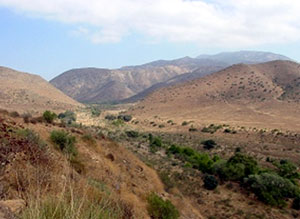Contact EPA Pacific Southwest Water Division
Pacific Southwest, Region 9
Serving: Arizona, California, Hawaii, Nevada, Pacific Islands, Tribal Nations
Watershed Priorities
National Links
Tijuana River Watershed, Baja California & CA
On this page:
The Tijuana River Watershed, lying between the U.S. and Mexico, is one of the fastest growing regions along the border. Almost 5 million people live in the San Diego, CA metropolitan area; over 1 million live in Tijuana, Baja California. The headwaters region, partly in Mexico, partly in the U.S., supports a flora and fauna so unique as to be considered a world biodiversity hotspot. The river empties into the Tijuana National Estuarine Reserve and the Pacific Ocean. Development in this water-scarce region is reducing the available habitat that supports its unique ecosystem.
Watershed Features

Tijuana watershed
The Tijuana River Watershed drains 1750 square miles, 3/4 of which lies in Mexico. It is bounded on the north by the Laguna Mountains in the U.S. and to the southwest by the Sierra Juárez in Mexico. Major tributaries are Cottonwood Creek (U.S.), Pine Creek (U.S.) and the Río Las Palmas system ( Mexico). The watershed is characterized by steep hilly terrain. The vegetation ranges from chaparral to coastal sage scrub, with conifer forests in the mountains, riparian zones and vernal pools, and wetlands in the estuary. The climate is Mediterranean, with annual temperatures ranging from 8 to 18 degrees C. Precipitation average 150mm/year (150-650mm range).
The rapidly expanding population in the watershed, particularly in the city of Tijuana, is covering the upland terrain with unplanned housing developments. Storms moving through deforested and vegetated hillsides send sediment down eroding gullies, bringing metals, PCBs, nutrients, pesticides and trash into the mouth of the river. Water quality is also compromised, and beach advisories are often posted during the wet weather season.
Watershed Projects
The Border 2012 Grant Program funded a binational volunteer beach monitoring program. Information about water quality at beaches in Mexico was posted on a website, in parallel to the EPA-funded BEACH Act monitoring program in San Diego County. Currently, EPA is funding a pilot program administered by the International Community Foundation to support locally initiated small projects to reduce sediment movement in the watershed.

Tijuana watershed
EPA worked with the International Boundary and Water Commission (IBWC), the City of San Diego, the Army Corps of Engineers (ACOE) and the California Regional Water Quality Control Board, San Diego Region, to oversee the construction of the International Wastewater Treatment Plant and South Bay Ocean Outfall which treats dry weather flows discharged into the Tijuana River.
The EPA Border Environment Infrastructure Fund (BEIF), working through the Border Environment Cooperation Commission (BECC) and the North American Development Bank (NADB) with the Comisión Nacional del Agua ( CNA) and the Comisión Estatal de Servicios Públicos de Tijuana (CESPT) has supported a number of wastewater-related projects, including development of a Tijuana 20-year Master Plan for drinking water and wastewater facilities and improvements to the wastewater collection system throughout the city.
Additional Watershed Projects and Partnerships
The Southwest Center for Environmental Research and Policy (SCERP), funded by EPA, has supported studies in the Tijuana Watershed conducted by San Diego State University and El Colegio de la Frontera Norte, from which a Tijuana River Watershed Atlas has been developed. The Baja California/California Water Task Force, convened in 2004, has taken as its work the implementation of the recommendations of the Tijuana Watershed Advisory Committee, a San Diego County-sponsored effort to survey watershed residents and to develop a document that contains information and recommendations for actions to restore and maintain ecological function and public health in the region.
EPA Contact
Elizabeth Borowiec (borowiec.elizabeth@epa.gov)
(415) 972-3419
